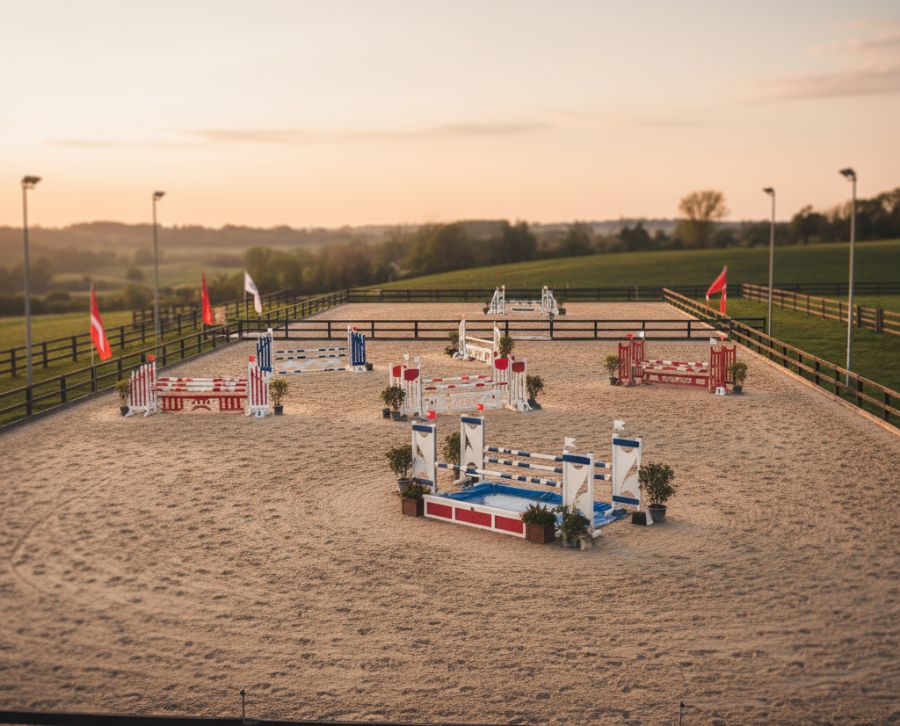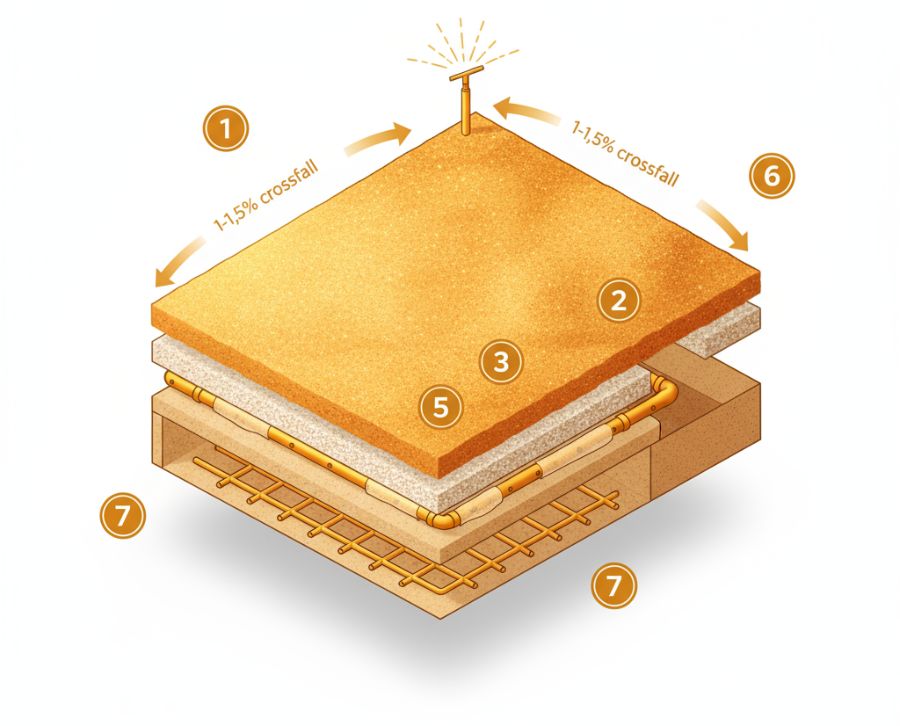When designing and equipping a show jumping arena, certain technical guidelines and procedures must be considered to ensure the model meets minimum quality standards.
For this reason, at EQUSPADDOCK we focus on offering equestrian equipment and accessories for horses in various disciplines. Our extensive experience in the market allows us to offer you advice and recommendations, such as those contained in this guide.

Strategic Planning: The Keys Before You Start
Before you begin designing and equipping a show jumping arena, it’s crucial to have a strategic and organized plan that allows you to meet your daily goals.
Defining your track’s objectives: training, competition, or school?
What will you be using the equestrian sports arena for? This way, you’ll know what materials to use and how to develop the infrastructure.
If the arena is for a show jumping center, you should consider the durability and safety of the elements, as well as the structures for the progressive learning process for novice riders and horses.
Location and orientation: taking advantage of the terrain and sunlight
To build the equestrian sports course, choose a naturally flat area with gentle, even slopes. This will minimize the need for earthmoving and leveling work.
Orientation is also essential. Ideally, the course should be located in a north-south direction to avoid direct sunlight for riders during sunrise or sunset.
Design and Dimensions: Creating the Perfect Canvas
When building a show jumping arena, it is essential to follow local regulations to create the perfect canvas.
Regulatory measures for jumping tracks
Typically, equestrian sports jumping arenas come in these sizes:
Standard. 40 m long and 20 m wide.
Wide. 60 m long and 20 m wide.
Small. 20 m long and 20 m wide.
However, you can sometimes find arenas that are 60 m long and 35 m wide.

The Importance of Effective Drainage: The Foundation of a Long-Lasting Runway
It’s also important to pay attention to drainage, as it’s the number one enemy of any show jumping arena. In this case, there are two main drainage systems:
Surface drainage. The arena should have a slight slope, between 1% and 1.5%. It must slope from the center to the sides.
Sub-drainage. This involves installing a network of perforated pipes under the base of the arena.
Also, keep in mind that the type of system will depend on the climate. In dry climates, a few trenches may be sufficient.
Entrances, exits and attached warm-up areas
These are key to maintaining an orderly flow of jumping horses. For this reason, you should build wide gates, between 3 and 4 m, so the horses can pass through easily.
Likewise, the warm-up area should be about 40 m long and 20 m wide. It’s important that it include at least one vertical jump and a landing area.
The track floor: The most important investment for the horse’s health
The surface of the arenas used by the equestrian center must be stable and consistent to allow for better jumping performance. A poor-quality surface increases the risk of injury, while a suitable surface provides support, safety, and confidence in every activity.
In general, you must be willing to invest what is necessary for the horse’s health. The quality of the surface directly influences athletic performance, so a good investment reduces veterinary costs.
Soil layers: Sub-base, base and tread layer
You should also pay attention to the layers of the floor, as is the case with the El Valle equestrian center. This way, the surface will be more resistant to time and weather.
Surface types: silica sand, geotextile, fibers and mixtures
It’s important to know that there are several types of surfaces for show jumping, such as waxed sand (freeze-resistant) and unwaxed sand (stable and economical).
The type of sand is also crucial. For example, silica sand creates a stable surface, but it tends to compact if it’s too fine. Geotextile sand retains moisture and increases cohesion. The fibers stabilize the sand.
Which floor should I choose? Advantages and disadvantages of each option
When choosing a flooring type, you should know its advantages and disadvantages:
Silica sand. It’s inexpensive and offers good drainage. However, it can shift during show jumping. It also requires constant watering.
Geotextile and fibers. This mixture provides cushioning, which provides comfort for the horse. It also reduces the need for constant watering. However, they tend to have a high initial cost.
For this reason, it’s key to understand which type of surface to choose based on the climate and the frequency of show jumping.
Essential equipment: complete jumping equipment
You need to pay attention to the essential equipment for horse sports:
Poles, Bars and Supports (Guides): The Foundation of Your Obstacles
Poles and bars are the most basic equipment for show jumping. They must be sturdy and have bright colors. And stands help adjust the height.
Repairs, walls and hedges: creating vertical obstacles
All these elements of the equestrian category must provide safety and flexibility to obtain a variety of configurations.
Estuaries and bidets: The waterfalls
These obstacles help improve horsemanship and jumping over water without touching it. They also enhance trust between rider and animal.
Dips, Oxers and Triple Bars: The Wingspan Jumps
Performing large jumps requires crucial safety equipment for both the rider and the horse and those assisting. These items can sometimes be found at an equestrian center online.
Boots and basic equipment for beginner riders
This equestrian item should provide support and safety. It should be made of leather or synthetic materials.
Safety elements: flags, numbers and protectors
The equestrian center’s flags indicate the area where the obstacle must be crossed. Numbers identify each component of the course. And the guards must prevent injury if the rider falls.
Auxiliary equipment: The details that make the difference
Ancillary equipment is also important. Here you can find accessories for riding and handling horses, such as saddles, blankets, bandages, reins, bits, and more.
Perimeter fencing: security and aesthetics
This is an equestrian element that prevents horses from escaping from the arena. It also provides security to keep visitors out of the facility. It can also contribute to the overall appearance of the center.
Irrigation system: sprinkler or subirrigation
If a sprinkler system is used, water can be distributed over the entire surface of the court. However, you can also choose to install a porous pipe system that delivers water to the lower layers of the soil.
Artificial lighting for night use
This component is crucial for equestrian and show jumping centers. It’s used to illuminate nighttime training and competitions, improving safety. LED lighting can be incorporated to maximize energy efficiency.
Material storage: specific carts and supports
The riding and jumping center should also have a storage space for horse safety equipment and other materials. It’s possible to incorporate compartments for various types of supplies.
Maintenance and care: extend the life of your rink
If you want to extend the lifespan of your equestrian track, you need to perform proper maintenance at the specified times.
Daily Tasks: Tracking and Leveling
You need to rake and level the arena daily. This way, you’ll keep the surface even and safe for show jumping. Make sure to mow the grass and remove any vegetation in and around the area.
Weekly and monthly tasks: humidity control and decompaction
Moisture maintains soil cohesion, so you should monitor it (through irrigation, additives, and a good drainage system) several times a day, depending on weather conditions and arena usage.
Furthermore, compaction work prevents the soil from becoming hard and dangerous for both riders and show jumping horses.
Replacement of materials and frequent repairs
You should also be aware of the replenishment of equestrian sports equipment. In that case, keep track of your warehouse with inventory management software. If you want something simpler, you can opt for an Excel list or similar.
Turn your project into reality with advice from Equs Paddock
If you want to make your project a reality, don’t forget to contact us. At EQUSPADDOCK, we have a wide catalog of products so you can build your equestrian show jumping arena like a pro.
Frequently asked questions about the jump track
North-south. Reduces glare and improves light uniformity throughout the day.
Minimum size: 60 x 40 m. Optimum for work and competitions: 80–90 m long by 50–60 m wide.
Between 1% and 1.5% transverse slope. Uniform and without tubs.
Silica sand with geotextile fibers, well leveled and with controlled humidity.
1.20–1.40 m fence and two wide entrances for safe entry/exit of horses and machinery.


